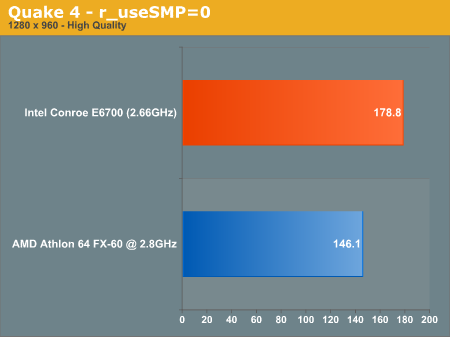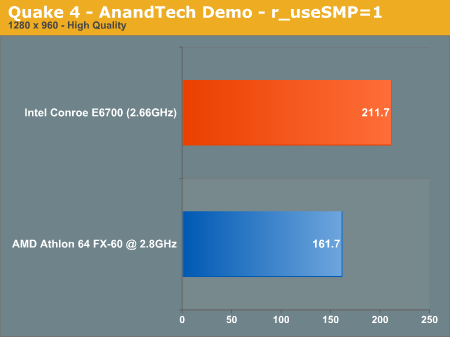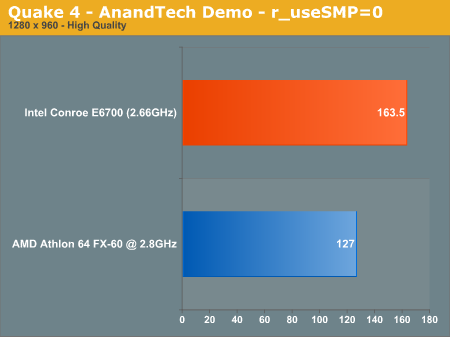Conroe Performance Preview Follow-Up
by Anand Lal Shimpi on March 9, 2006 9:30 AM EST- Posted in
- Trade Shows
The Benchmark Issue
Although we mentioned that there’s not much you can do to make a timedemo really favor one CPU architecture over another, you all demanded that we try with one of our demos. We put our Quake 4 demo file on a USB drive and copied it over to the Conroe and Athlon 64 FX-60 systems that Intel had setup. Note that the version of Quake 4 installed was 1.0.5.0 which is newer than what we test with in our CPU reviews, so you can’t directly compare the numbers to previous AnandTech results but at least we’d be able to see if Intel’s Quake 4 demo was somehow giving Conroe the unfair advantage.
We re-ran Intel’s Quake 4 demo to confirm our initial results. Much to our surprise, we actually short-changed Intel the first time around. We noted that Conroe held a 28% performance advantage over the 2.8GHz Athlon 64 FX-60 with SMP disabled, but with it enabled the performance advantage shrunk to 15%. We re-tested and confirmed our suspicions that Conroe’s Quake 4 performance with SMP enabled was more in line at a 24% advantage:


But what we’re really interested in is how Conroe performed in the very same Quake 4 demo that has been favoring AMD processors in all of our CPU reviews. We loaded up our Quake 4 demo and had at it:


With SMP enabled we see that Conroe holds an even larger 31% performance advantage and with it disabled, the unreleased CPU was 29% faster. If anything, Intel’s own demo was a little more conservative on Conroe and definitely not optimized to make AMD look bad.










96 Comments
View All Comments
fitten - Thursday, March 9, 2006 - link
Right conclusion, wrong cause. What really "halves the cache" is pointers (which have to be 64-bit now instead of 32-bit). Programs that use few pointers will show little difference in cache usage. Programs that use lots of pointers (read: written in Java, C#, and those type languages) will show increase cache usage from all the larger pointers. 64-bit and 64-bit instruction set does not imply that the instructions are actually 64-bits long, in fact, it rarely implies that (64-bit RISC processors, for example, tend to have all/mostly/many 32-bit instructions, just like their 32-bit processor counterparts, for example).Nighteye2 - Thursday, March 9, 2006 - link
I'm not saying it halves the cache. Just that the instructions are longer, not necessarily 64 bits long. I expect the difference to be more like a quarter, rather than half, if I'd have to make a guess at it.AlexWade - Thursday, March 9, 2006 - link
AMD forced Intel to make a first-rate CPU. And the good news is we win. I knew Intel couldn't stay down forever. Neither will AMD. I think it still bothers Intel, however, that they have to use AMD's 64-bit code.Am I reading this correctly that Conroe is a single-core CPU? I would like to know more about dual-core CPU's, that is the future.
fitten - Thursday, March 9, 2006 - link
From what I've heard in the rumor mill (nothing that anyone else can't hear), there will be no single-core Conroe chips. I'm sure marketing pressure might lead to them, though. The test system definitely had a dual-core Conroe, though.Von Matrices - Thursday, March 9, 2006 - link
No single core Celeron Conroes?pnyffeler - Thursday, March 9, 2006 - link
I have to agree. I've been building AMD rigs for many years and have always pulled for the underdog, but I have to tip my hat to the Intel man on this one. They have raised the bar after getting smacked in the forehead with it for too long.Intel had become pretty lazy over the past few years, and I think it took way too long to realize that they were peddling 2nd rate products that wasted enough heat to qualify as a space heater.
AMD also has done well in this, too. By building a no-question better product, they were able to steal a good chunk of the market share, and their momentum right now will be hard to beat. Now I'm waiting for AMD's counter punch, and from what I've seen so far, if they think it's the AM2 with DDR2, they're gonna get steam-rolled.
cscpianoman - Thursday, March 9, 2006 - link
This is Intel!Sorry, had to be an ostrich fan-boy for the moment. I think it interesting that Intel really upped the ante on this one. They didn't want to match AMD's next stuff, they wanted to clobber it. Unless AMD pulls a rabbit out of their hat, I see Intel holding onto this performance crown. I'm interested to see what AMD has to counter this.
psychobriggsy - Thursday, March 9, 2006 - link
Even I, as an AMD supporter, hope that this will shut up the extremist ostrich-like fanboys on the AMD side who can't see that Intel has finally done well.It will be interesting to see a comparison between Conroe at $x and a Pentium D at $x when they're released too.
And well done for admitting a fault with the FEAR test.
mongster - Friday, March 10, 2006 - link
Agree with you. Been an Intel supporter for many years and when it was time to upgrade my flailing Willamette system, I decided to wait for Prescott, thinking that I don't want to jump onto the AMD bandwagon. When AMD trounced Intel Prescott, I decided to wait for dual core. But when AnandTech and other sites put out convincing data on why AMD continues to be the better buy for CPU's, I decided it was high time to switch over to the other camp. That was what I did last year when I finally assembled my first AMD system (have assembled AMD systems for my friends but never for myself). Now, I am thinking, should I have waited? Conroe's numbers sure are impressive but I will wait for the architecture to mature first (and the prices to stabilize haha) and see if AMD has anything up their sleeves to counter Conroe.Just my 2 cents.
Calin - Monday, March 13, 2006 - link
Yes, if your old computer's performance was enough, you should have waited another 6 or more months for Conroe. If you were concerned about price, maybe you should have waited until early next year.When you choose to upgrade, Intel wasn't the clear cut best option, like it seems to become in half a year